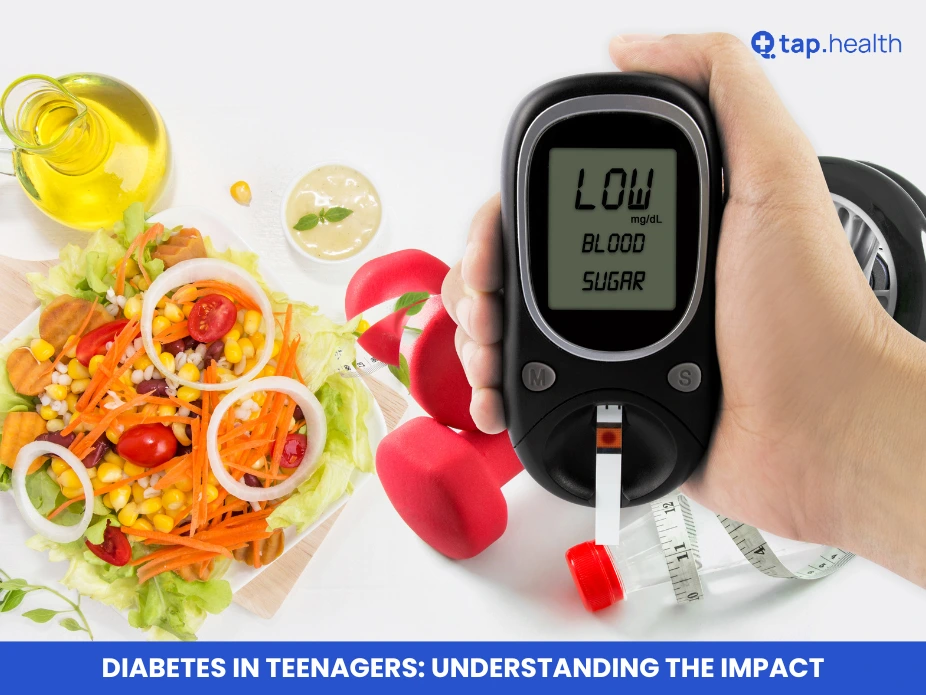Diabetes, a chronic condition that affects the body’s ability to regulate blood sugar, is becoming increasingly common among teenagers. Although diabetes is typically associated with adults, the rise in teenage obesity and poor dietary habits has led to an alarming increase in both Type 1 and Type 2 diabetes cases among adolescents. In this article, we will explore the different types of diabetes in teenagers, their symptoms, causes, and the best strategies for managing the condition.
Types of Diabetes in Teenagers
There are two primary types of diabetes that can affect teenagers: Type 1 Diabetes and Type 2 Diabetes.
1. Type 1 Diabetes in Teenagers
Type 1 diabetes, also known as insulin-dependent diabetes, is an autoimmune condition where the immune system attacks and destroys the insulin-producing cells in the pancreas. This form of diabetes is most often diagnosed in childhood or adolescence and typically requires lifelong insulin therapy.
Causes and Risk Factors
- Genetics: A family history of Type 1 diabetes can increase a teenager’s risk.
- Autoimmune Response: The body mistakenly attacks its own insulin-producing cells, often triggered by viral infections.
- Ethnicity: Teenagers of European descent are at higher risk.
Symptoms
- Increased thirst and urination
- Extreme fatigue
- Unexplained weight loss
- Blurred vision
- Frequent infections
2. Type 2 Diabetes in Teenagers
Type 2 diabetes occurs when the body either does not produce enough insulin or the insulin produced is not used effectively (insulin resistance). This form of diabetes is typically linked to lifestyle factors, such as obesity, a sedentary lifestyle, and poor diet, and is more common in teenagers who are overweight.
Causes and Risk Factors
- Obesity: Excess body fat, especially abdominal fat, increases insulin resistance.
- Lack of Physical Activity: A sedentary lifestyle contributes to insulin resistance.
- Family History: A family history of Type 2 diabetes increases the risk.
- Poor Diet: Diets high in processed foods, sugar, and fats contribute to the development of Type 2 diabetes.
Symptoms
- Increased hunger
- Frequent urination
- Fatigue
- Dark skin patches (especially around the neck or armpits)
- Slow-healing wounds or infections
Managing Diabetes in Teenagers
Teenagers with diabetes need a well-rounded approach to management, including medication, diet, exercise, and emotional support. Let’s dive into how to manage diabetes effectively in this age group.
1. Medication and Insulin Therapy
For Type 1 diabetes, insulin therapy is essential. Teenagers must learn how to monitor their blood sugar levels and administer insulin injections or use an insulin pump. Insulin is required throughout the day, and its dosage may need to be adjusted based on activity levels and food intake.
For Type 2 diabetes, medication such as metformin is commonly prescribed to help the body respond better to insulin. In some cases, lifestyle changes like exercise and dietary improvements can be enough to manage the condition, particularly in its early stages.
2. A Healthy Diet
Diet plays a significant role in managing both Type 1 and Type 2 diabetes. A balanced diet that includes whole grains, lean proteins, healthy fats, and plenty of fruits and vegetables can help control blood sugar levels.
- Carbohydrate Counting: Teens with Type 1 diabetes often need to count carbohydrates to balance insulin doses.
- Low Glycemic Index Foods: Foods that have a low glycemic index, such as whole grains, legumes, and non-starchy vegetables, help prevent rapid spikes in blood sugar.
- Limit Sugary Snacks and Beverages: Teenagers with Type 2 diabetes, in particular, need to avoid sugary foods and drinks that can lead to insulin resistance.
3. Regular Exercise
Exercise is crucial for managing Type 2 diabetes and can help teenagers with Type 1 diabetes improve insulin sensitivity. Physical activity helps the body use insulin more effectively and can help maintain a healthy weight.
- Moderate-intensity Exercise: Teens should aim for at least 60 minutes of moderate-intensity exercise most days of the week.
- Strength Training: Incorporating strength training into their exercise routine can help build muscle mass, which improves insulin sensitivity.
4. Blood Sugar Monitoring
For both types of diabetes, regular blood sugar monitoring is essential. Teens should learn how to check their blood glucose levels multiple times a day, especially before and after meals, and make adjustments to their insulin doses as needed.
5. Psychological Support
Managing diabetes as a teenager can be emotionally challenging. The pressures of maintaining blood sugar levels, making dietary choices, and adhering to a medication regimen can lead to stress and anxiety. Therefore, psychological support is vital.
- Family Support: Encouragement from family members helps reduce feelings of isolation and frustration.
- Therapy or Counseling: Psychological counseling can help teenagers cope with the emotional challenges of living with diabetes.
- Peer Support Groups: Connecting with others who have diabetes can reduce the sense of being different and provide practical coping strategies.
Real-Life Scenarios
Scenario 1: Sarah, 16 Years Old – Type 1 Diabetes
Sarah, a 16-year-old high school student, was diagnosed with Type 1 diabetes when she was 12. Over the years, she has learned to manage her blood sugar with insulin injections and has developed a healthy eating plan with the help of a dietitian. Sarah enjoys swimming and participates in regular exercise to maintain a healthy weight. Despite her busy school schedule, she ensures she monitors her blood glucose levels frequently. The support of her family and a close-knit group of friends has been crucial to her emotional well-being, helping her feel in control of her diabetes.
Scenario 2: Alex, 17 Years Old – Type 2 Diabetes
Alex, a 17-year-old teenager, was recently diagnosed with Type 2 diabetes. His parents had noticed he had gained significant weight over the past few years and struggled with fatigue. With guidance from his healthcare team, Alex adopted a healthier lifestyle, including daily exercise and cutting back on sugary snacks. He has also started taking medication to help manage his blood sugar levels. Although adjusting to the new routine was challenging at first, Alex now feels more energized and confident in his ability to manage his condition.
Expert Contributions
Dr. Emily Thompson, a pediatric endocrinologist, states, “The rise of Type 2 diabetes in teenagers is largely due to lifestyle factors like poor diet and lack of physical activity. The good news is that with the right interventions, many teens can reverse early Type 2 diabetes through diet, exercise, and weight loss.”
Dr. John Matthews, a clinical psychologist specializing in chronic illness, emphasizes, “Diabetes is not just a physical condition—it affects the emotional and mental health of teenagers. It’s crucial to provide mental health support to help teens navigate the challenges of diabetes management.”
Recommendations Grounded in Proven Research and Facts
- Early Diagnosis: According to the Centers for Disease Control and Prevention (CDC), early diagnosis and intervention are crucial in managing diabetes in teenagers, especially for Type 2 diabetes. Early lifestyle changes can prevent or delay the progression of the disease (Source: CDC).
- Lifestyle Modifications: The American Diabetes Association (ADA) emphasizes that a healthy diet, regular physical activity, and maintaining a healthy weight are essential for managing Type 2 diabetes, especially in teenagers (Source: ADA).
- Insulin Management: Research published in The Lancet Diabetes & Endocrinology found that tight control of blood sugar levels through insulin management significantly improves long-term health outcomes for teenagers with Type 1 diabetes (Source: The Lancet).
Factual and Reliable Information
The information provided in this article is based on current research and expert guidelines. The key recommendations for managing diabetes in teenagers, including proper diet, exercise, and medication, are aligned with best practices in the field of diabetes care.
FAQ on Diabetes in Teenagers: Understanding the Impact
Q1: Can teenagers develop Type 2 diabetes?
A1: Yes, Type 2 diabetes is increasingly common among teenagers, especially due to the rise in obesity, poor dietary habits, and sedentary lifestyles.
Q2: How is Type 1 diabetes diagnosed in teenagers?
A2: Type 1 diabetes is diagnosed through blood tests that measure blood glucose levels. Teenagers may also experience symptoms like extreme thirst, frequent urination, and weight loss.
Q3: How can parents help their teenagers manage diabetes?
A3: Parents can help by encouraging healthy eating habits, supporting exercise routines, ensuring proper medication adherence, and offering emotional support.
Q4: Are there long-term complications of diabetes in teenagers?
A4: Yes, if poorly managed, diabetes can lead to complications like heart disease, kidney problems, and nerve damage. Early diagnosis and consistent management are key to preventing these issues.
Q5: Can exercise help teenagers with Type 1 or Type 2 diabetes?
A5: Absolutely! Regular physical activity helps manage blood sugar levels, improves insulin sensitivity, and contributes to overall well-being for both Type 1 and Type 2 diabetes.



